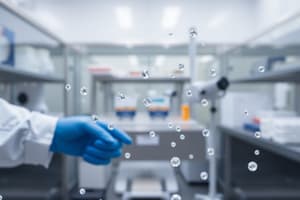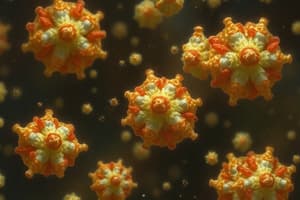Podcast
Questions and Answers
What is the primary focus of pharmaceutical microbiology?
What is the primary focus of pharmaceutical microbiology?
- Preventing microbial contamination in pharmaceuticals (correct)
- Developing new pharmaceutical compounds
- Increasing the shelf-life of pharmaceutical products
- Enhancing the effectiveness of antibiotics
Which method is commonly used for sterility testing in pharmaceutical microbiology?
Which method is commonly used for sterility testing in pharmaceutical microbiology?
- Liquid chromatography
- Membrane filtration (correct)
- Gas chromatography
- Immunoassay technique
What are key indicators in environmental monitoring within pharmaceutical microbiology?
What are key indicators in environmental monitoring within pharmaceutical microbiology?
- Chemical composition of the product
- Temperature and humidity levels
- Shelf-life and potency of the product
- Bioburden levels and contamination patterns (correct)
Why is antimicrobial effectiveness testing particularly important for multi-use products?
Why is antimicrobial effectiveness testing particularly important for multi-use products?
Which agency is NOT typically involved in the regulatory compliance of pharmaceutical microbiology?
Which agency is NOT typically involved in the regulatory compliance of pharmaceutical microbiology?
Flashcards are hidden until you start studying
Study Notes
Overview of Pharmaceutical Microbiology
- Study of microorganisms in pharmaceutical products
- Focuses on prevention of microbial contamination
- Ensures safety, efficacy, and quality of pharmaceuticals
Key Areas of Pharmaceutical Microbiology
-
Microbial Contamination
- Sources: Raw materials, equipment, and personnel
- Types: Bacteria, fungi, viruses
- Importance of contamination control in product safety
-
Sterility Testing
- Ensures product is free from viable microorganisms
- Common methods:
- Membrane filtration
- Direct inoculation
- Regulatory guidelines (e.g., USP, EP)
-
Antimicrobial Effectiveness Testing
- Assesses a product's ability to inhibit microbial growth
- Important for multi-use products
- Typically involves challenge testing with known pathogens
-
Environmental Monitoring
- Regular assessment of cleanrooms and production areas
- Techniques include air sampling, surface sampling, and personnel monitoring
- Key indicators: Bioburden levels, contamination patterns
-
Quality Control and Assurance
- Implementation of Good Manufacturing Practices (GMP)
- Quality by Design (QbD) principles to reduce microbial risks
- Use of risk assessments for contamination sources
Importance of Pharmaceutical Microbiology
- Protects patients from infections caused by contaminated medications
- Contributes to the development of safe and effective pharmaceuticals
- Regulatory compliance is crucial for approval and market access
Regulatory Considerations
- Governed by agencies such as FDA, EMA, and WHO
- Adherence to pharmacopoeial standards (USP, EP, JP)
- Need for regular audits and inspections for compliance
Emerging Trends
- Increase in biopharmaceuticals and biologics
- Advances in microbial testing technologies (e.g., rapid microbiological methods)
- Focus on antibiotic resistance and the impact on pharmaceutical development
Pharmaceutical Microbiology Overview
- Focuses on preventing microbial contamination to ensure safe, effective, and high-quality pharmaceuticals.
- Examines microorganisms found in pharmaceutical products.
Key Areas in Pharmaceutical Microbiology
Microbial Contamination
- Raw materials, manufacturing equipment, and personnel are common sources of contamination.
- Bacteria, fungi, and viruses are the main types of microorganisms that contaminate pharmaceuticals.
- Contamination control is crucial to ensure product safety.
Sterility Testing
- Checks for viable microorganisms in pharmaceutical products.
- Methods include membrane filtration and direct inoculation.
- Regulatory guidelines ensure sterility testing meets specific standards.
Antimicrobial Effectiveness Testing
- Evaluates a product's ability to inhibit microbial growth.
- Important for multi-use pharmaceutical products.
- Involves testing using known pathogens to challenge the product.
Environmental Monitoring
- Regularly assesses cleanrooms and production areas to identify potential microbial contamination risks.
- Techniques include air sampling, surface sampling, and personnel monitoring.
- Bioburden levels and contamination patterns are monitored.
Quality Control and Assurance
- GMP (Good Manufacturing Practices) are implemented to prevent contamination.
- QbD (Quality by Design) principles are used to proactively reduce microbial risks.
- Risk assessments identify potential contamination sources.
Importance of Pharmaceutical Microbiology
- Protects patients from infections caused by contaminated medications.
- Ensures the development of safe and effective pharmaceuticals.
- Essential for regulatory compliance, which is needed for product approval and market access.
Regulatory Considerations
- Regulated by international agencies such as FDA, EMA, and WHO.
- Requires adherence to pharmacopoeial standards such as USP, EP, and JP.
- Subject to regular audits and inspections to ensure compliance.
Emerging Trends
- Increasing focus on biopharmaceuticals and biologics.
- Advances in microbial testing technologies, including rapid microbiological methods, are being implemented.
- Growing concern about antibiotic resistance and its impact on pharmaceutical development.
Studying That Suits You
Use AI to generate personalized quizzes and flashcards to suit your learning preferences.




